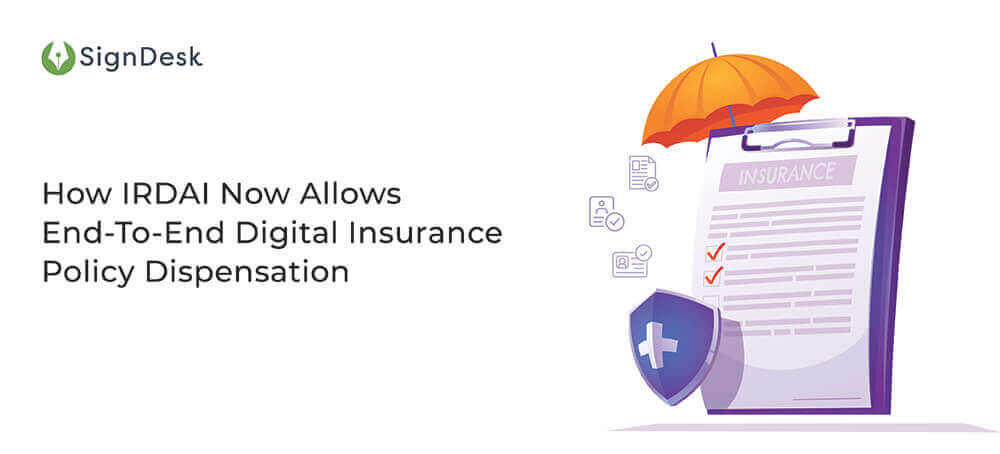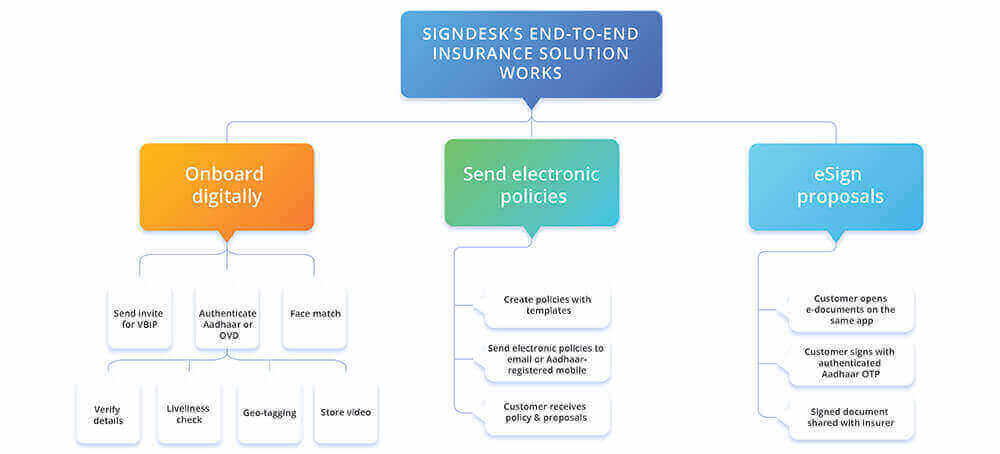Rapid digitization in the insurance sector
Over the last month, IRDAI has issued two circulars: one permitting video KYC for insurance onboarding and the other allowing insurers to issue electronic insurance policies and obtain e-signatures from customers to consent to policy proposals.
These circulars have been met with much fanfare by insurers who have recognised the need for digital onboarding during the COVID-19 pandemic, and the potential of digitized methods to cut KYC costs and provide insurance to customers quickly and safely.
However, what most people don’t realize is that these circulars can be interpreted in conjunction with each other and the methods illustrated in each circular can be combined to create an end-to-end digital system to onboard customers, send electronic policies, and obtain consent remotely.

Implications of VBIP and electronic policies
IRDAI VBIP allows insurers to onboard customers using video-based KYC methods, wherein the customer’s KYC and identifying documents such as Aadhaar or any e-signed officially valid document (OVD) are verified by an official in a video interaction. The official additionally matches the customer’s identity with the picture on the identifying documents to complete the onboarding process.
This entire process takes place online, on a suitably seamless and encrypted application.
IRDAI’s second circular allows insurers to send electronic policies to customers (after obtaining consent to do the same), and obtain the customer’s consent for these policies by electronically signing a digital proposal form.
Note here that these two processes are completely digital and hence can be combined into an end-to-end procedure simply by extending the scope of the application used for VBIP to accommodate digital documents and an eSign facility.
All this sounds good in theory, but how will such an end-to-end application work?
End-to-end digital platform for insurance onboarding and electronic policies
SignDesk offers both an IRDAI-compliant product for VBIP and an eSign suite with document templates and Aadhaar eSign. Insurers could use these solutions separately to onboard customers and then obtain consent through Aadhaar-based OTP.
However, they can also be combined to create a seamless platform for customers to be onboarded, receiving electronic policy documents, and e-signing the requisite proposals.
Such an automated solution would help insurers get their policies out quicker, significantly decrease the turnaround time on obtaining signatures, and would provide customers with a truly seamless experience in which onboarding, policy dispensation, and policy acceptance would all be completed within minutes.
Here’s how SignDesk’s end-to-end insurance solution works.

SignDesk’s digital suite of products are therefore perfectly suited to provide insurers a completely digital method of onboarding and policy dispensation.
Additionally, insurance premium payments can also be automated using our NPCI-compliant eNACH product, which supports mandate authentication via Aadhaar eSign.
Insurers can sit back and allow this completely automated system to work its magic, while also cutting down on documentation costs, decreasing TAT, and increasing customer acquisition due to the ease of these digital methods.
Trusted and award-winning documentation solutions
Our video KYC and eSign solutions are trusted by 350+ clients including 50+ major banks, and have won several awards including the Global Banking and Finance Review’s Best Digital Onboarding Product of 2020 in India.
We use the latest in AI and ML to verify identities, perform facial matches, root out identity fraud, and ensure client data security. Our solutions support APIs, desktop and web browsers, and mobile SDKs, and have resulted in 90% reduction in onboarding costs and nearly 120 hours saved per customer for clients.
Curious to learn more about our end-to-end insurance dispensation solution? Book a free demo with us now!